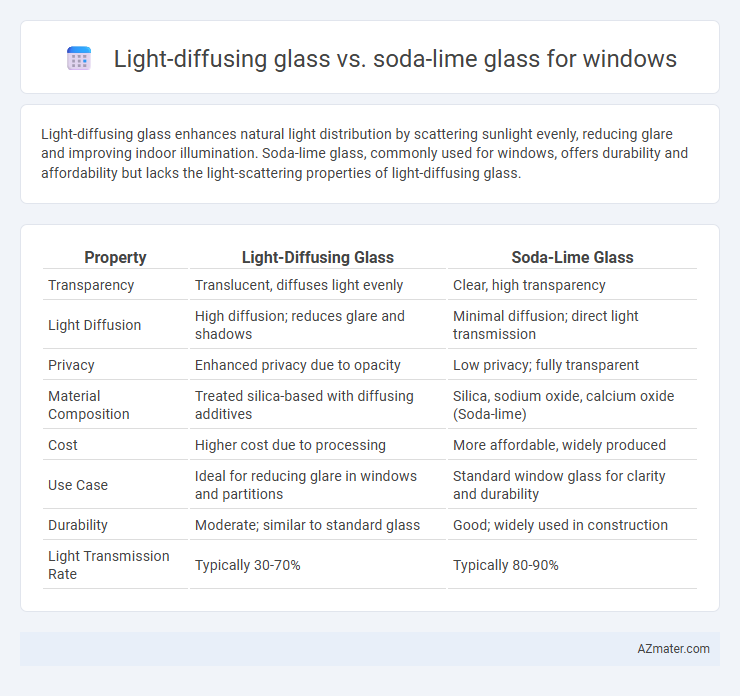Light-diffusing glass enhances natural light distribution by scattering sunlight evenly, reducing glare and improving indoor illumination. Soda-lime glass, commonly used for windows, offers durability and affordability but lacks the light-scattering properties of light-diffusing glass.
Table of Comparison
| Property | Light-Diffusing Glass | Soda-Lime Glass |
|---|---|---|
| Transparency | Translucent, diffuses light evenly | Clear, high transparency |
| Light Diffusion | High diffusion; reduces glare and shadows | Minimal diffusion; direct light transmission |
| Privacy | Enhanced privacy due to opacity | Low privacy; fully transparent |
| Material Composition | Treated silica-based with diffusing additives | Silica, sodium oxide, calcium oxide (Soda-lime) |
| Cost | Higher cost due to processing | More affordable, widely produced |
| Use Case | Ideal for reducing glare in windows and partitions | Standard window glass for clarity and durability |
| Durability | Moderate; similar to standard glass | Good; widely used in construction |
| Light Transmission Rate | Typically 30-70% | Typically 80-90% |
Introduction to Light-diffusing Glass and Soda-lime Glass
Light-diffusing glass enhances natural light distribution by scattering sunlight to reduce glare and improve indoor comfort, making it ideal for energy-efficient window applications. Soda-lime glass, the most common type of glass used in windows, offers affordability and durability but lacks the light-scattering properties found in light-diffusing variants. Choosing between these glasses depends on balancing cost, aesthetic preferences, and the need for controlled light diffusion in architectural designs.
Composition and Manufacturing Differences
Light-diffusing glass incorporates additives such as ceramic frits or polymers during its manufacturing to scatter light uniformly, enhancing privacy and reducing glare, while soda-lime glass primarily consists of silica, sodium oxide, and calcium oxide, produced through the float glass process for clarity and durability. The manufacturing of light-diffusing glass involves extra processing steps like coating or embedding diffusing particles to achieve translucent effects, contrasting with the straightforward melting and forming phase of soda-lime glass. These compositional and manufacturing differences result in distinct optical properties suited to specific window applications where controlled light transmission is essential.
Light Diffusion Properties
Light-diffusing glass significantly enhances indoor illumination by scattering incoming sunlight, reducing glare and creating a uniform light distribution compared to soda-lime glass, which transmits light more directly with less diffusion. This diffusion property in light-diffusing glass improves visual comfort, minimizes sharp shadows, and contributes to energy efficiency by maximizing natural light utilization. Unlike soda-lime glass, commonly used for its affordability and structural properties, light-diffusing glass is specially engineered with micro- or nano-scale textures or coatings to optimize light scattering while maintaining transparency.
Clarity and Transparency Comparison
Light-diffusing glass enhances privacy by scattering incoming light, reducing direct clarity while maintaining overall brightness, making it ideal for settings requiring obscured visibility. Soda-lime glass offers superior transparency and clarity, providing an unobstructed view and allowing maximum natural light transmission, commonly used in standard window applications. The choice depends on whether visual privacy or clear visibility is the priority in the window design.
Energy Efficiency and Insulation
Light-diffusing glass enhances energy efficiency by reducing glare and distributing natural light evenly, minimizing reliance on artificial lighting and improving thermal comfort. Its specialized surface scatters incoming sunlight, which contributes to better insulation by preventing excessive heat gain or loss compared to soda-lime glass. Soda-lime glass, while common and cost-effective, offers lower thermal insulation and energy-saving properties, making light-diffusing glass a superior choice for energy-efficient window applications.
Durability and Maintenance Needs
Light-diffusing glass offers enhanced durability due to its specialized coatings or textured surface that resist scratches and reduce visible wear over time, making it ideal for high-traffic window applications. Soda-lime glass, the most common window glass, provides standard durability but is more prone to scratches and chips, requiring more frequent maintenance or replacement in rigorous environments. Maintenance for light-diffusing glass often involves gentle cleaning products to preserve its optical properties, while soda-lime glass can tolerate more straightforward cleaning methods but may degrade visually faster under harsh conditions.
Aesthetic and Design Applications
Light-diffusing glass enhances window aesthetics by softening natural light and creating a uniform glow, ideal for privacy and modern interior designs. Soda-lime glass offers clarity and versatility, maintaining transparency while providing a clean, minimalist appearance suitable for traditional and contemporary settings. Designers prioritize light-diffusing glass for ambient, glare-free illumination, whereas soda-lime glass is favored for maximizing visibility and natural views.
Cost Considerations
Light-diffusing glass typically incurs higher initial costs compared to soda-lime glass due to its specialized manufacturing process that enhances light distribution and reduces glare. Soda-lime glass, widely used in standard windows, remains the most cost-effective option because of its abundance and simple production methods. For projects balancing budget and performance, soda-lime glass offers a lower upfront price, while light-diffusing glass may provide long-term value through energy savings and improved interior lighting quality.
Environmental Impact and Sustainability
Light-diffusing glass enhances natural light distribution, reducing reliance on artificial lighting and lowering energy consumption, which contributes to a smaller carbon footprint compared to traditional soda-lime glass. Soda-lime glass, while widely used due to its low cost and recyclability, typically requires more energy-intensive processing and offers limited light diffusion properties, leading to higher energy usage for indoor lighting. Choosing light-diffusing glass supports sustainability goals by improving energy efficiency and enabling greater use of renewable daylight in building design.
Choosing the Right Glass for Your Window
Light-diffusing glass enhances natural light distribution while reducing glare and maintaining privacy, ideal for spaces requiring soft, even illumination. Soda-lime glass offers cost-effective durability and clarity, commonly used in standard window applications for clear outdoor views. Selecting the right glass depends on balancing light diffusion needs, privacy preferences, and budget constraints for optimal window performance.

Infographic: Light-diffusing glass vs Soda-lime glass for Window
 azmater.com
azmater.com